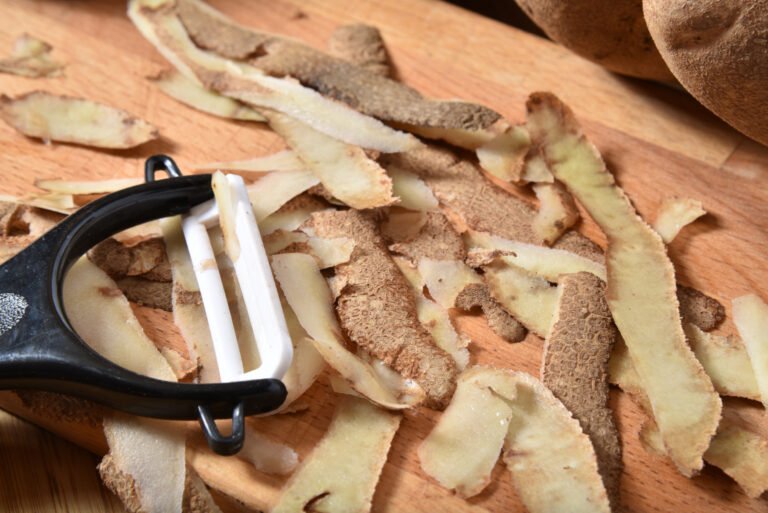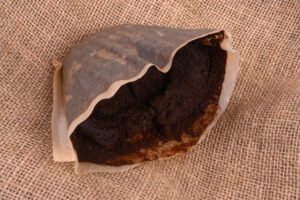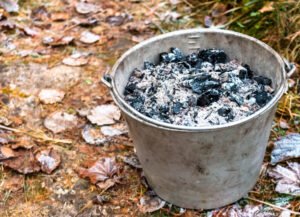Potatoes really are one of the most consumed vegetables worldwide. And it’s not only great for delicious dishes but can be used as a great source of organic matter for your soil. But how? Can you compost potato peels? And how does it benefit the soil? Let’s dig in!
Key Takeaways
- Potato peels are compostable as they are rich in macro-nutrients like Nitrogen, Phosphorus, Potassium, and Calcium and serve as organic humus.
- Since potato peels are biodegradable, they can be easily composted via Hot Composting and Vermicomposting, which are explained in the steps below!
- It’s crucial to avoid composting potato or sweet potato peels that are rotten or contain brown patches as they might be infected with blight and harm the soil.
- Potato peels are not just useful for composting but also in making a nutritious fertilizer. You can learn more about making the potato peel fertilizer and compost below!
How To Compost Potato Peels?
Vegetable peels are easily decomposable and hence can be composted easily through simple methods like hot composting, cold composting, vermicomposting, etc.
If you already have a compost pile ready, you just need to wash the potato skins, add them to the bin and turn it regularly. The active microbes in a pile will carry out the rest of the process.
But, if you are starting your compost bin from scratch, here are the steps you need to follow, and you are good to go.
Step 1. Wash the Potatoes Peels
For composting potato peels, you first need to pick fresh and healthy potato skins and wash them thoroughly. Then, cut the peels into smaller pieces to fasten the decomposition.
Step 2. Prepare the Compost Bin
Take a composting bin that is around 3 feet deep. You can DIY the bin with a medium-sized plastic container with some holes poked around it.
Step 3. Add Some Browns and Greens
Add some brown materials like wood chips, dry leaves, yard waste, paper, twigs, dried branches, etc. Browns are rich in carbon and serve as food for decomposers.
Then, add a layer of some greens over the browns. It includes garden waste, weeds, grass clippings, food scraps like coffee and tea grounds, and of course, potato peels.
Greens are rich in Nitrogen and help in the growth of microbes, thus quickening the breakdown process.
Step 4. Repeat the Layers
Add the layers of browns and greens alternatively until you finish all the waste materials. Keep each layer 3 inches deep, water them, and fill the compost pile.
The best ratio of greens and browns for composting is 3-4 parts brown material to 1 part green material. However, 1-1 ratio will also work effectively in the right composting conditions.
Step 5. Add Water to Compost Pile
Water your compost pile regularly and make sure it is sufficiently moist. Do not overwater as excess water might rot your compost pile and make it smelly.
Step 6. Turn the Pile
Turn the pile once every few weeks. Stirring the pile helps aerate the pile, generating heat and preventing bad odor. The heat will keep the potato peels safe from Blight as it would kill all the fungal spores.
After taking good care of your compost heap, you will get the final compost in 10-12 weeks.
Can You Compost Potato Peels In a Worm Bin?
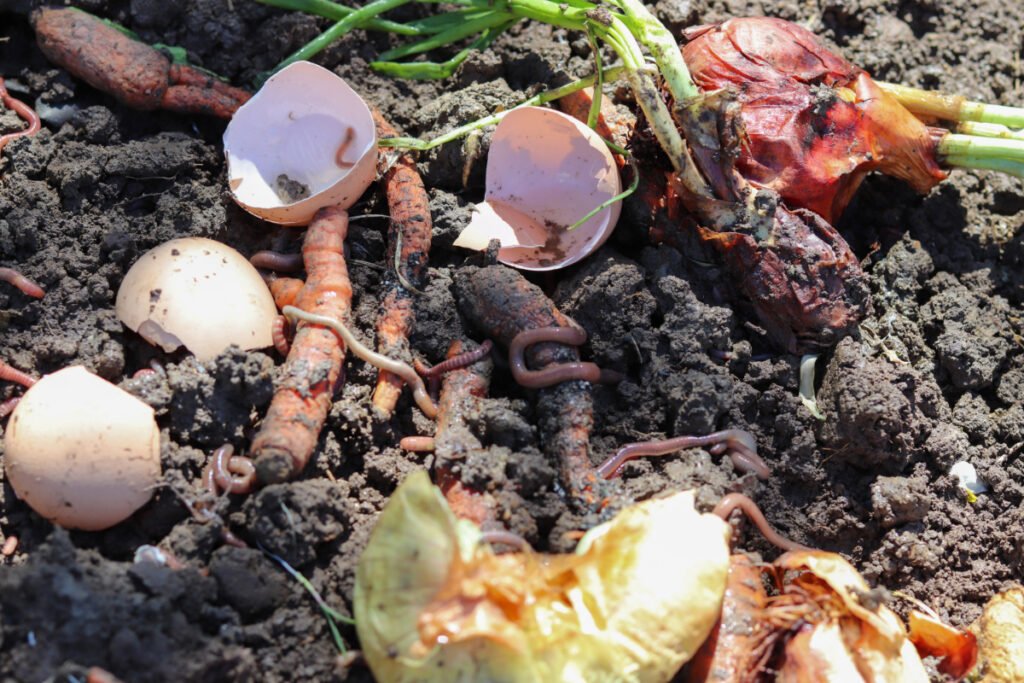
Potato peels can definitely go to worm bins for vermicomposting. Simply add the peels to the bin with other food scraps.
The only concern is that it takes longer to compost due to the solanine present in the skins. It makes the decomposition slower, as the worms eat the bacteria first before feeding on the peels.
So, if you want to add potato skin to your worm bin, it is best to put them in moderation.
Moreover, cooked and mashed potato or boiled potato skins may have less solanine, making it easier for the worms to act upon and hasten their decomposition.
Benefits of Composting Potato Peels
Composting potato skin is a great way to recycle the major source of food waste in your homes. This comes with multiple benefits, which are listed below.
- Potato peel helps add vital nutrients like Nitrogen, Phosphorous, Potassium, Magnesium, and Calcium to your compost pile.
- The compost made of potato peels would become a good source of organic nutrients for the plants.
- The potato peel compost can be provided to plants in any season.
- Potato peels are biodegradable and can be decomposed easily; thus, they are environmentally friendly.
- Composting potato waste at home is easy and does not need any scientific knowledge.
- It is cost-effective and saves you from buying costly fertilizer.
Additional Tips For Composting Potato Peels
Potatoes are highly susceptible to a fungal disease called Potato Blight, and composting infected potato peelings may encourage fungal growth. Using this compost might destroy your garden, especially tomato and potato crops.
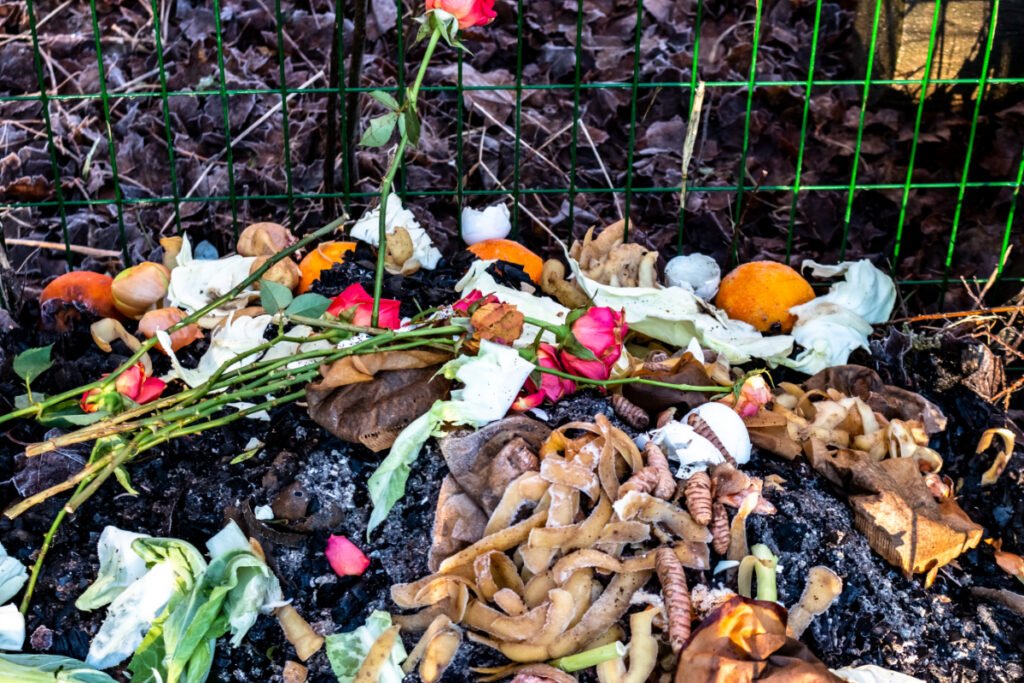
So, here are some tips you need to follow before composting potato peels.
- To avoid the development of spores, store the potatoes in dark, cool places.
- Do not add the peels from rotten potatoes or ones with brown patches.
- Bury the potato peel deep inside the compost heap to prevent sprouting. (Remember, blight spores can survive only on living plant material)
- You can also use cooked potato skin for composting. Cooked peels will not sprout and also decompose quickly.
- You can make liquid fertilizer from raw potato peels and reuse these peels for composting.
How To Make Potato Peel Fertilizer?
As the potatoes are loaded with nutrients, you can also use the potato peels to make liquid fertilizer.
Here are the steps you need to follow to make the liquid fertilizer:
- Cut the fresh potato peels into small pieces.
- Add the peel chips to a container.
- Add some water to the container.
- Close the lid tightly and leave it for 3-4 days.
- Strain the water, and fill this liquid fertilizer in a spray bottle to use in your garden. You can add the left peels for composting again.
Is potato skin good for the soil?
Potato skin is excellent for soil health as it is packed with Nitrogen, Phosphorous, and Potassium, thus adding essential nutrients to the soil organically. These nutrients make the soil fertile and fit for growing crops.
How long do potato peels take to compost?
Potato peels generally take 10-12 weeks to turn into fine soil, which will be fit for use as compost in your garden. However, 75-80 % of the decomposition will be done within 5-6 weeks of making the compost pit.
How do you keep potatoes from sprouting in compost?
Potatoes store heat within them. Burying them deep down in the compost pile generates excess heat and prevents them from sprouting in the compost pit.
How to identify potatoes infected with Blight?
The infected potato tubers contain dark patches and eventually start rotting from the skin to the center. So, while composting, use the potato peels with no brown patches and are not rotten.
Can we use a whole potato for composting?
Adding a whole potato or large chunks of potato is not recommended as they can sprout. This might encourage the growth of Blight spores as the fungus survives on living plant material. Moreover, adding a whole potato makes the decomposition slower.
Can you compost potatoes infected with Blight?
Potatoes infected with blight should not be used for composting as it would encourage the fungus to grow and spread in the bin. Moreover, if used in the garden, this infected compost would harm your plants, especially potatoes and tomatoes, and the soil would not be fit for growing crops for 4-5 years.
Well, now you know that potato peels can be composted and are excellent for the soil. So, next time you cook delicious mashed potatoes, store the peels and toss them in your compost bin.
Similarly, if you love oranges and want to know if you can compost orange peels or not, here is everything you need to know.
